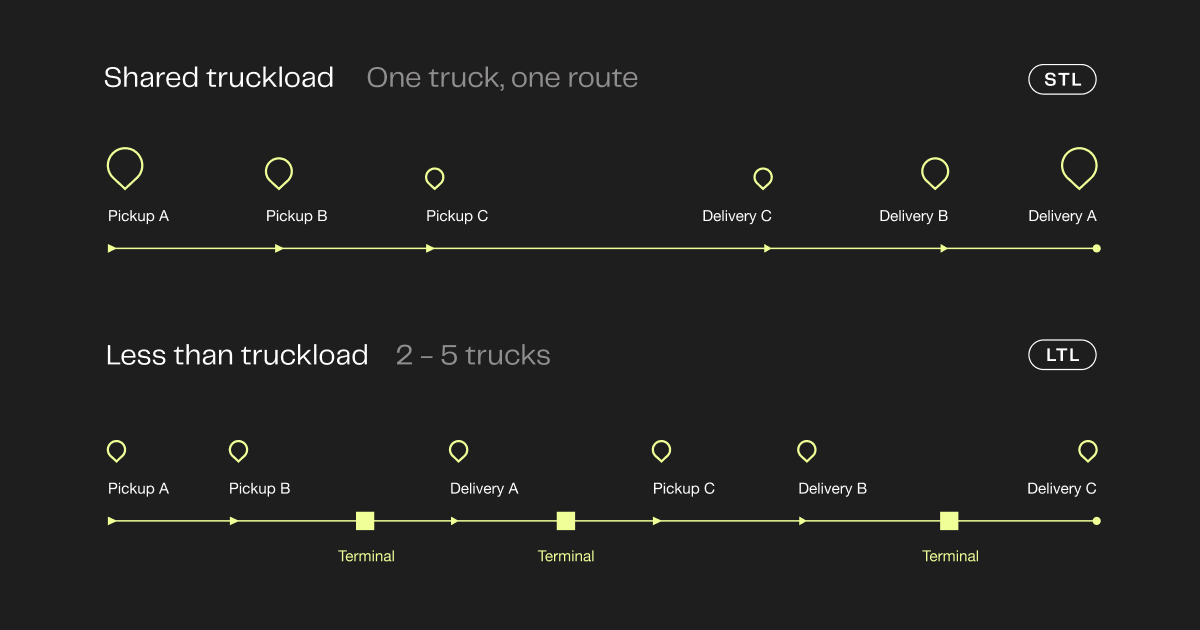Volume LTL Shipping: What It Is & When To Use It.

Volume LTL (VLTL) freight is a shipping method for loads that fall between less than truckload (LTL) and full-truckload (TL) sizes. This method helps shippers and carriers who are looking for a better solution to common shipping inefficiencies of LTL and TL, such as wasted trailer space.
How does volume LTL work?
Due to the enormous complexity of LTL freight networks, even the most efficient carriers inevitably end up with partially empty trucks on the road. When you ship volume LTL, your freight is transported by filling those gaps in standard LTL shipments.VLTL freight typically ranges from 6 to 24 pallets, filling 12 to 32 linear feet in a trailer, and/or weighing at least 5,000 pounds. However, every carrier sets their own exact dimensions for volume LTL shipments.
What are the benefits of volume LTL?
Shipping VLTL offers several key benefits:
- more cost effective: shipping VLTL is typically cheaper than LTL and TL because carriers will offer lower rates in exchange for filling gaps in shipments as they arise
- reduced risk of damages: VLTL shipments usually stay in the same trailer throughout the trip, unlike LTL freight
- greater capacity: while the LTL and TL markets are currently experiencing a tightening of capacity, VLTL enables shippers to tap into underused, empty backhauls
What are the drawbacks to volume LTL?
As with every shipping mode, there are downsides to shipping VLTL as well:
- slower and less predictable: shipping VLTL requires that space be available in other shipments, often moving at the convenience of the carrier’s schedule
- lower cargo liability limit: VLTL isn’t suited for high-value freight, with a liability limit of $1 per pound; that’s far below the standard LTL limits of between $5 and $25 per pound
VLTL vs. standard LTL.
With standard LTL shipping, carriers pick up freight from multiple shippers and bring everything back to a central hub to organize it by destination. Drivers then take shipments to another hub closer to their final destination, where carriers sort them again for local delivery. This shipping method requires that trucks maximize their freight loads at all times to remain cost-effective, but LTL networks are hugely complicated and prone to inefficiencies that lead to empty truck space. Volume LTL shipping offers a great opportunity for shippers and carriers to benefit from that underused space. Volume LTL shipments are usually cheaper than shipping LTL; however, VLTL shipments follow less predictable schedules than LTL, since they must wait for space to become available.
How does VLTL differ from partial truckload (PTL)?
Partial truckload (PTL) and volume LTL are sometimes used interchangeably, but there are some key differences. Because VLTL uses the LTL network, comparing partial truckload vs. LTL is very similar:
- PTL uses the TL carrier network, while VLTL uses the LTL network.
- PTL doesn’t require a designated freight class, with rates established by the market. Volume LTL rates are based on your carrier’s LTL prices, which require freight classification.
- PTL freight is typically shipped straight through with a predictable delivery window, while VLTL is shipped at the carrier’s convenience.
When should you ship volume LTL?
Volume LTL shipping is an excellent choice for shippers looking to save money on bigger, low-liability cargo with flexible delivery windows. VLTL is also a good alternative when freight capacity in the TL and LTL markets is tight, as it is currently.


.jpg)


